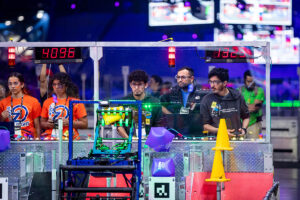The Action-packed FIRST Robotics Games will start Mar. 14

Hundreds of high school students from Utah and surrounding states will converge on March 14 for the Utah Regional FIRST Robotics Competition. The annual tournament involves teams designing and building robots that play a physical, action-packed game against one another.
The event, co-organized by the University of Utah’s John and Marcia Price College of Engineering and held at the Maverik Center in West Valley, is free and open to the public.
The FIRST (For Inspiration and Recognition of Science and Technology) Robotics Competition aims to promote science and technology education for high school students around the world, fostering a new generation of engineers, programmers, and scientists.
“FIRST gets kids involved in STEM in a fun way, solving real-world science, engineering, and business problems. Those aspects are critical for developing our economy and future leaders,” says Mark Minor, associate professor in the Price College’s Department of Mechanical Engineering and Organizing Chair of the Utah Regional FIRST Robotics Competition.
“It also prepares them to come to the U with skills that go beyond engineering. Just learning how to be part of a team is so important for emotional support, building confidence, and making friends.”
Minor and his colleagues at the University of Utah Robotics Center first organized the state’s chapter of the national robotics competition as an outreach program through a National Science Foundation grant in 2010 and have been helping run the annual event since.
To participate, students form teams, then are tasked with designing and building an industrial-size, semi-autonomous robot to compete in this year’s FIRST game.
Called “Reefscape,” this year’s game takes place on a simulated seabed, with exercise balls standing in for algae that needs to be harvested, and PVC tubing serving as segments of coral that must be rearranged. Trios of teams are grouped into “alliances,” which then deploy their robots around a field of play about the size of half a tennis court. The three-on-three game involves robots flinging the algae into overhead nets, stacking coral on their reef, and clinging to hanging diving cages before the final whistle blows. Coordination between robots, along with well-timed actions from their humans, can earn teams bonus points.
Teams must program their robots to operate autonomously for the first 15 seconds of the two-and-a-half-minute matches, then may manually pilot them to execute more complicated maneuvers. Teams must therefore engineer their robots with high degrees of mechanical precision and reliability, but also develop strategy, teamwork, and other interpersonal skills, in order to come out on top.
The latter are particularly important in FIRST, as each match is between two alliances of three teams and their robots; while individual teams have had months to fine-tune their designs and strategies amongst themselves, they must also be ready to quickly coordinate with the other members of their alliance in each match.
In the spirit of FIRST’s principle of combining competition with cooperation, opposing alliances can also score “Coopertition Points” by coordinating with each other at certain times in the match. Beyond boosting the alliance’s score in the match, Coopertition Points also improve teams’ overall standing in the tournament rankings.
The tournament culminates in championship matches and an award ceremony for various other team and individual achievements. Teams that perform the best in the autonomous portion of matches, or who best demonstrate the principles of FIRST, for example, are recognized.
“One of the principles we teach is ‘Gracious Professionalism,’“ says Sara Whitbeck, who serves as a coach for one of the teams based out of Murray’s Academy for Math, Engineering & Science (AMES). “More than a specific code of conduct, it’s about learning to balance knowledge, pride, and empathy — to be a strong competitor while also respecting and supporting your opponents.”
Even more than technical skills, it’s these interpersonal lessons that stay with competitors.
“The FIRST robotics competition taught me that overcoming challenges and hard work can be fun, which prepared me for college and my career as a mechanical engineer at ALTA Racks,” says Tren Hirschi, who competed for AMES as a student and now advises Cottonwood High School’s team. “I now have the opportunity to pass on that experience as a mentor.”
Teams that win the Utah Regional Competition, as well as winners of select technical and performance-based awards will move on to the FIRST Championship, held April 16–19 in Houston, Texas.